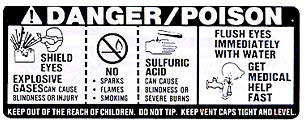
[Source: BCI (Battery Council International)]
CAR AND DEEP CYCLE BATTERY
FREQUENTLY ASKED QUESTIONS 7.1
Bill Darden
Last Updated on February 25, 2008
Words of caution: Lead-acid batteries contain a diluted sulfuric acid electrolyte, which is a highly corrosive poison and will produce flammable and toxic gasses when recharged and explode if ignited. According to PREVENT BLINDNESS AMERICA, in 2003 nearly 6,000 motorists suffered serious eye injuries from working around car batteries. The U.S. Eye Injury Registry reports that it is the third leading cause of eye injuries at home. When working with batteries, you need to wear glasses (or preferably Z-87 rated safety goggles), have plenty of ventilation, remove your jewelry, and exercise caution. Do NOT allow battery electrolyte to mix with salt water. Even small quantities of this combination will produce chlorine gas that can KILL you! If available, please always follow the manufacturer's instructions for testing, jumping, installing, discharging, charging, equalizing and maintaining batteries.

[Source: BCI (Battery Council International)]
Car batteries are used to start a gasoline or diesel engines found in approximately 370 million cars, light trucks and vans worldwide. This FAQ also applies to approximately 68 million motive and stationary deep cycle batteries and an estimated 130 million additional starting batteries found in trucks, SUVs, motorcycles, recreation vehicles (RVs), motor homes, caravans, boats, power sports (snowmobiles and jet skis), tractors, etc. This FAQ assumes 12-volt, six cell, negative grounded, lead-acid car and deep cycle batteries at 80° F (26.7° C) with capacities from 5 Amp Hours (AH) to 250 AH. The terms "starting", "SLI" and "cranking" are used for car batteries but would apply to any lead-acid battery used to start an engine. When used alone, the generic term "battery", applies to both lead-acid car, other starting, motive and stationary deep cycle batteries. For 6-volt batteries, divide the 12-volt battery voltages in this FAQ by two; for 8-volt batteries, divide by 1.5; for 24-volt batteries, double the voltage; for 36-volt batteries, triple the voltage; and for 48-volt batteries, multiply by four. Hyperlinks to battery glossaries and dictionaries can be found in the Battery References Link List on http://www.batteryfaq.org/.
Warnings and other important information are in BOLD text, and the technical stuff, recommendations and tips are in italics.
1. WHAT IS THE BOTTOM LINE AND TIPS?
2. HOW ARE BATTERIES MADE? WORK? and DIE? and WHY NEGATIVELY GROUNDED?
3. HOW DO I PERFORM PREVENTIVE MAINTENANCE?
5. HOW DO I KNOW IF MY VEHICLE'S CHARGING SYSTEM IS OK OR LARGE ENOUGH?
6. HOW DO I JUMP START MY VEHICLE?
7. WHAT DO I LOOK FOR IN BUYING A NEW BATTERY?
8. HOW DO I INSTALL NEW BATTERIES?
9. HOW DO I CHARGE (OR EQUALIZE) MY BATTERY?
10. WHAT CAUSES MY BATTERY TO DRAIN OVERNIGHT?
11. HOW CAN I INCREASE THE LIFE OF MY BATTERY?
12. WHAT ARE THE COMMON CAUSES OF PREMATURE BATTERY FAILURES?
13. HOW CAN I STORE (OR WINTERIZE) BATTERIES?
14. WHAT ARE THE MYTHS ABOUT BATTERIES?
15. HOW LONG CAN I PARK MY VEHICLE?
16. HOW CAN I REVIVE A SULFATED BATTERY?
17. WHY WON'T MY ENGINE START?
18. WHERE CAN I FIND MORE INFORMATION ON BATTERIES?
The best source of information about your battery is the manufacturer who made it. Some manufacturers do any excellent job of informing and educating their customers about their batteries, by enclosing the information with each battery or on their Web sites. Ideally, the battery manufacturer should print the most important consumer information on the battery label such as specifications, 100% State-of-Charge definitions, charging voltages, etc. If the information is not readily available, ask the manufacturer to provide it. If they are unwilling, use another manufacturer's product. This information is absolutely essential to properly charging and maintaining the battery and obtaining the optimal performance and service life from your investment.
![]()